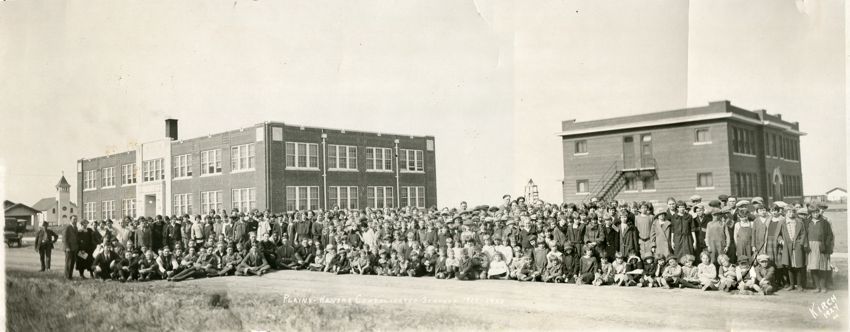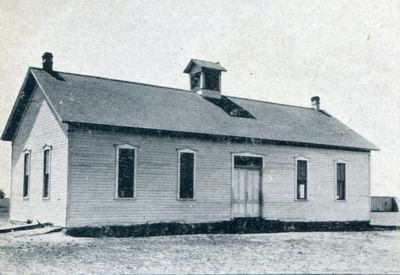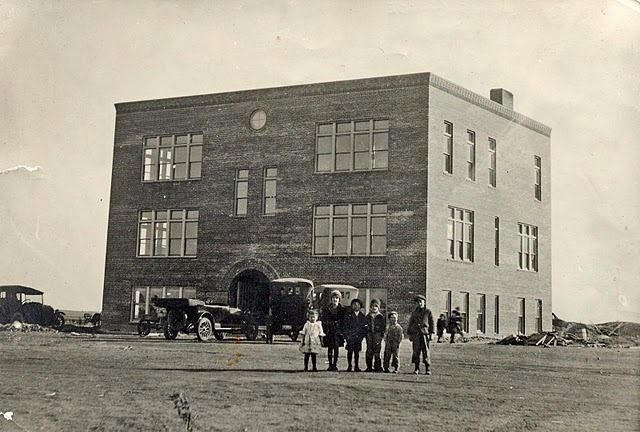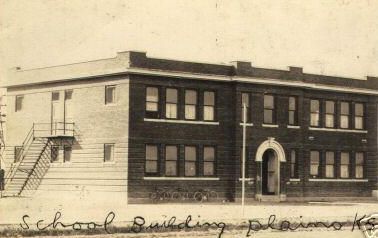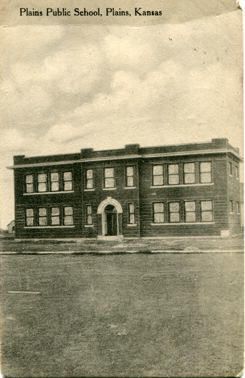Plains Schools
From “Plains, Kansas – 100 Years” - Schools -1887 through 1985
As the people came west and having no schools, they would often volunteer their homes and then as time permitted, they would build. One of the earlier schools in town in 1885, was a store building rented and transformed into a school house. A Mr. Don T. Edwards was one of the dozen school children. He was eight years old. The first class was taught by Lizzie McClung.
Two years later, material was hauled from Cimarron for a two-room school building which was completed in 1887. It was built near the site of the former Theis Streiff home and later became a part of it. Mrs. R. R. Singley taught for an eight-month term in 1891-92. Others who taught were Miss Clara Ellis and Mr. A.L. Vaught (1903), and' Tom Dillinger (1887).
After the railroad was built in 1888, the school house in Plains was moved to the present site. During the hard times in 1903-07, the two-room school dwindled to a one-room school and a Miss Ruth Bennett, who was also county superintendent, consented to be the teacher. The one elected from Missouri had stayed only one month and resigned.
In 1893, in early West Plains, school was held in the Ebenezer Taylor home, two large rooms with six to eight students attending. It was also used as a place for public meets, dances and church affairs. Jack Evans, a Liberal businessman and county treasurer, was the first teacher. In 1894, the school changed to a big one room house which was a house from one of the settlers. It was three and one-half miles west and one mile south of the original West Plains. Five to six years later, not enough students attended to hire a teacher, so each student was allowed ten dollars a month to go to some other school.
The Eli Keller one-half dugout home thirteen miles southeast of Plains was also used one time as a school.
By 1909, there were several schools in the vicinity: #4, 14, 15, 30, 34, 39, 40, 50, 58, 59, 60 and 16. These schools were later consolidated into the Plains Consolidated system #74.
As prosperity came and the need for more room. A third room was annexed to the Plains School. Mr. William Calvert was the first superintendent. He also taught grades six, seven and eight. Mrs. William Newby taught grades one and two. Mrs. Gillidett taught grades three, four and five.
In 1912, to satisfy added interests, a school board composed of Dr. G.A. Nickelson, D.J. Davis and W.W. Coons, chose to have a brick building built. Mr. Fred Calvert, who served until at least 1925, introduced and taught subjects of a two-year high school course during the year 1912-13. Claude Holmes and James Gillidett were enrolled as freshmen. Mr. Calvert was succeeded by: Paul Helsel, R.M. Sutcliffe, Chas. L. Moody, W.C. Fowler, Me Nyquist, and H.C. Van Voorhis.
The first class to graduate from the Plains High School was in 1919: Haskell Holmes, Minnie Angell and Neva Dailey.
By 1920, a consolidation proposal was made by the school board for the consolidation of the territory in and around the city, taking in as many districts as would vote to go into consolidation. Then in 1922, with Nyquist as superintendent, the district voted for a new school building. After Christmas the school was occupied.
Floyd Drury was principal. Others were: Miss Peterson, high school principal, 5 years; Miss M. Ona Houston, 12 years; Mrs. Gillidett, 8 years; and Miss Peterson, 7 years; Miss Johnson, 6 years; and Mr. Van Voorhis, 4 years (as of 1925).
Board members since 1912: Roy Elliot, 13 years; Roy Traylor, 10 years; I.D. Golliher, 6 years; Others were: W.W. Coons, E.G. Gillidett, E.M. Angell and A.C. Krause. From time forward to 1925, high school has gone from 68-110 students and advanced from class C to class A, belonging to North Central Association of Colleges and Secondary Schools.
In 1925, the high school maintained three separate types of courses: General, College Preparatory and Commercial. Over 400 books had been added to the library. Forty-nine seniors out of eighty had graduated within the years of 1923-1925.
Again in 1947, the patrons voted for expansion and an industrial arts building was built. The gymnasium was increased to double its former size. During the summer of 1950, a lighting system for football was installed in Plains. On Saturday, September 23, at the first night football game ever held in the city of Plains, the American Legion Post No. 312, in a special ceremony, dedicated the field "Memorial Field" in memory of those who gave their lives in W.W.II.
There were six who lost their lives: Jack Staples, Joe Flemming, John Hatcher, Donald Knott, Bob Elliott and Charles Woltje. There were approximately 1,000 who attended the occasion.
In 1959, a beautiful new brick building was completed to hold the increased grade enrollment. It had spacious rooms for kindergarten through eighth grade. Also a multipurpose room for all indoor sports, a well-equipped kitchen, adequate office space and a first aid and counseling room.
Haskell Holmes, one of the first graduates, served on the school board for twenty years. During the election of 1960, he asked not to be nominated again. At this time, W.E. Woodard held the record for the longest tenure as superintendent -ten years from 1929-39.
Some other superintendents and principals to be recorded in history were: A. H. Bergen, superintendent; A.J. Seely, principal; D C. Bradner; Charles Gibson; Lester L. Paul; and D. Hennelgh.
With the expansion and larger enrollment, a decision was made for a larger high school. Plains and Kismet consolidated and on July 1, 1966, became a fully unified school district #483. Before that they were organized as a Common School District #1 on July I, 1964.
The members of the board were: J.O. Borth, E. Fred Foster, Charles Breen, Lyman Brown, John Reimer and Max Roberts. The interim board at the time of construction was: Jay Otto Borth, E. Fred Foster, Dean Headrick, Charles Breen, H.G. Adams III. Howard E. Gray was superintendent of schools, Donald Hennigh was high school principal. Howard Gray was superintendent thirteen years before leaving in 1979, when Jim Miller became the superintendent. The 1985 school board members are: Butch Amerin (who took the place of Gerald Jacobs) Vonn Richardson, Don Thorp, Karen Miller (in place of T.B. Lee) Sam Douglas and Warren Fox.
Early History of Meade High School
Taken from the pages of the Meade County Historical Society 1885 History Book (copyright)
Written in 1962 by Laura S. Smith
Since records of the first schools in Meade are no longer in existence, the early part of this history is based on my own memory of the events I heard discussed as a child which had happened some years earlier, and on the memory of others who were here at that time.
The late Robert A. Brannan recalled that he was a pupil in the first school held in the town of Meade. That was in the winter of 1885 and 1886. The school was held in a store building which faced the north on Carthage Avenue, about midway between Fowler and Spring Lake Streets. Finances were by subscription, as school districts were not yet sufficiently organized to receive funds for operation. The first teacher was a Mr. Charley Edwards. Mr. Brannan also recalled the name of Melissa Louks as a teacher there. She may have been the second teacher.
Later schools were held in other buildings during the early years. A building somewhere near the intersection of West Plains and Meade Center Streets housed some of the pupils, and another on East Carthage, east of Meade Center Street, held another group. These locations are according to the memories of the late Brother Buis and William Wehrle, and of Mrs. Eva Coon, all of whom attended classes in those places. The late Mrs. M.W. (Carrie) Anschutz recalled attending classes in the Christian Church, on the site of the present Baptist Church.
About that time the district began the erection of a school building, located on the site of present Meade City school buildings. It was named the Washington School, and opened In the fall of 1888. It was a two-storey structure, containing six classrooms with a full basement, which was used for play rooms in stormy weather. There was a bell tower with a bell large enough to be heard for two or three miles.
Three teachers divided the 60 or so pupils into more or less ungraded groups. In the early 1900s, a fourth teacher was added and an attempt was made to arrange the pupils in formal grades. Some of the early-day teachers who gave splendid instruction were Tillie Turner, Jennie Kessler, Abbie Wightman (who later became Mrs. Abbie Bodle and had a long teaching career in the schools), Lou Bodle, A.T. Bodle, Ormond Hamilton, Florence Richardson, Sada Jenkins, C.P. Dawson, and Ross McCormick, to name only a few.
All through the years, a few high school subjects had been taught to older pupils. Such subjects depended upon the interest and preparation of the instructor. So early-day students had some fine ground work in such subjects as mathematics, science, Latin, German, English, and bookkeeping.
However, there came a demand for more formal high school work, and a three-year course was established in 1903. Several classes were graduated from this course.
In 1909, the school board, consisting of James Wilson, M.C. Read, and Frank Bennett, called a meeting of the highest class in the school and asked them what they planned to do the following year. The class replied that they expected to go on to school. The year of 1910 saw a repetition of the same called meeting, and the determination of the class to finish high school.
At that time, the State Superintendent W.D. Ross, and the Superintendent of the schools at Atchison, Kansas, came to Meade as an examining board to give tests and examinations to determine how well the school stood academically for accreditation as a four year high school The result was satisfactory.
In the fall of 1911, Joe N. Hamilton came to Meade as Superintendent and assistant teachers were Florence Lennen and Bertha Davis. The Washington building still housed the eight grades and the high school. It was remodeled inside to add another class room, and a science laboratory, tiny but complete, as well as a domestic science rooms in the basement. So, in 1912, the first class from a four year accredited high school was graduated.
In 1916, the Bennett building was built to house the grade school and in 1926, the new high school building was erected. The upper story of the Washington building was removed, and classrooms were rearranged to accommodate the seventh and eighth grades, and other classes. A new grade school building and gymnasium was built in 1950, the Bennett building was razed to make room for it, and in 1959 the Washington building was removed when a new wing was added to the high school.
A vocational agriculture course was added, and a suitable building was placed on land acquired for the purpose east of the school campus.
